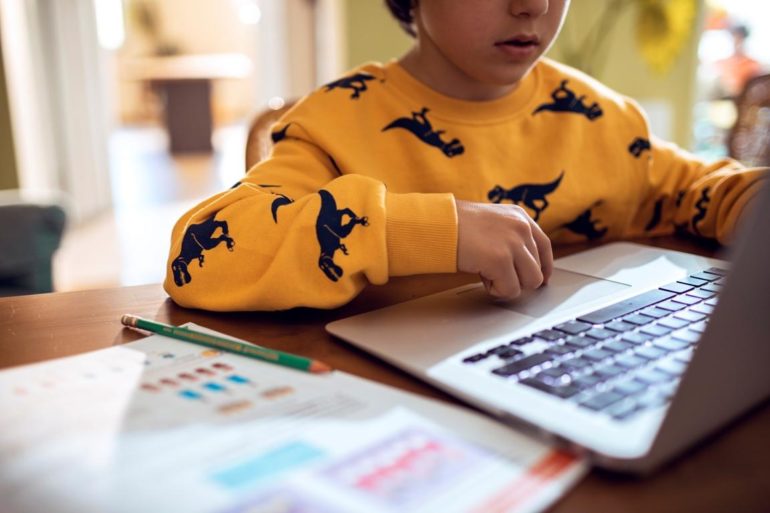Some of the most striking inequalities in internet access are found among children.
Marko Geber / DigitalVision / Getty Images
Grocery shopping, banking, working: there is hardly any aspect of modern life that cannot be done online – and yet there are still 1.5 million homes in the UK that have no access to the internet, according to new research carried out by communication watchdog Ofcom.
Up to 6% of households in the country were reported to be completely offline last year, almost half of which said that the internet was “too complicated” for them. Other barriers to access included lack of interest, with 42% of respondents arguing that they didn’t see the need for connectivity.
For more than a third of households (36%), the barrier came from the cost of access to the internet being too prohibitive.
Although the numbers are still significant, the situation is improving: the previous year, Ofcom registered 11% of offline households across the UK.
Since then, the COVID-19 pandemic has forced many users to resort to digital means to access critical services while the country remained in lockdown. For some of those with limited digital skills, the crisis was a catalyst for change, forcing them to embrace new technologies and gain confidence online.
From online shopping to applying for a new driving license through video-calling apps, many started using the internet to carry out services that they would have done in-person before, which contributed to narrowing the digital skills gap, especially between older and younger generations.
But this also means that those who are still left behind are likely to feel even more disempowered than before, according to Ofcom. Groups least likely to have home internet access were those aged over 65, as well as households with lower incomes or that are financially vulnerable.
For example, while 97% of the more privileged socio-economic groups use the internet at home, that is only the case of 86% of those from the least privileged group.
These groups may have felt more acutely the disadvantages of being offline, such as social isolation or being less able to complete certain activities.
As healthcare services switched online, for instance, and tele-medicine became the norm over the past months, those with no internet connection would have found it much harder to book a consultation with their GP.
“For many people, lockdown will leave a lasting legacy of improved online access and better digital understanding. But for a significant minority of adults and children, it’s only served to intensify the digital divide,” said Yih-Choung The, Ofcom’s strategy and research group director.
Some of the most striking inequalities in internet access are found among children. While Ofcom reported that nearly all children aged between five and 15 years old were able to go online at home (less than 1% were offline), the research also showed that not all children were given the same opportunities when it comes to how they accessed the internet.
In financially vulnerable households, children were 89% likely to have access to a desktop or laptop – while the percentage jumps to 98% in the least financially vulnerable homes.
As schools turned to remote working last year, this means that children from less privileged backgrounds found it harder to access a suitable device for online education and missed out on learnings compared to their wealthier peers.
Among those who did not have full-time access to a device at home, two-thirds of children had to share a device to manage home schooling, and 3% said that they were unable to do their schoolwork.
“It’s positive that virtually all children now have access to the internet at home, but the big problem is access to a device, with a sizeable proportion of children having to share,” Nick Davies, program director at the Institute for Government, who did not participate in the research, tells ZDNet.
“This is further evidence of big disparities in the access of wealthier students versus more disadvantaged students to remote learning during the crisis. Wealthier students got more time to spend on educational activities during the pandemic, contributing to a widening attainment gap.”
Davies published a report last year looking at the distribution of laptops and tablets for children across the country, and at how inequalities impacted education. He found that, during lockdown, wealthier students spent around 75 more minutes a day on educational activities than the least well-off pupils, partly as a result of better access to devices for online learning.
In the long term, missing out on schooling because of a lack of digital equipment could result in 2.5% less earnings later in life, as well as higher chances of unemployment and of living in poverty.
The UK government has unlocked millions of pounds worth of laptops and Wi-Fi routers for some disadvantaged pupils, with up to 1.3 million laptops and tablets deployed so far. But as Ofcom’s research suggests, the gap in access to the internet between financially vulnerable children and households that are more well-off is still salient.
“Students have lost education time to a lesser or to a greater extent,” says Davies. “The question is what happens if schools close again. We are hoping, even though it is expected that there won’t be further lockdowns, that the government does have a plan in place to make sure that disadvantaged students don’t fall further behind if school closures become necessary again.”
In addition to assessing how connected the country is, Ofcom’s research also sheds a light on the way that different groups use the internet. For example, the analysis shows that the use of video-sharing platforms was nearly universal among children, and the majority also reported gaming and using social media.
Gaming also grew among adults, with 62% saying that they were playing games on any type of device. Young adults showed a more diverse use of social media, and TikTok got a special mention for rising in popularity, from 5.4 million to 12.9 million users in the first months of 2020.
